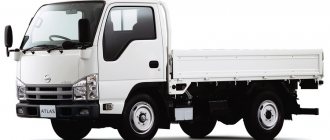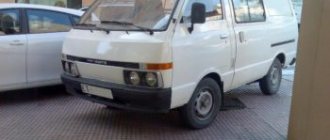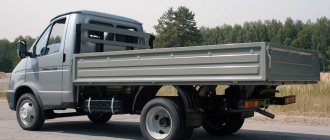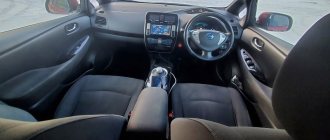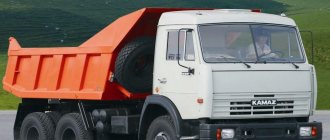The TD27 engine was created for medium-sized sea and river vessels, therefore it runs on diesel fuel, has a huge margin of reliability, rotation from the crankshaft to the camshaft is transmitted by a gear rather than a belt. Manufacturer Nissan has decided to use the TD series on several models of minivans and SUVs.
Basic version of the TD27 naturally aspirated diesel engine with attachments.
The naturally aspirated version was used very rarely, mainly on the Nissan Atlas; the turbo modifications TD27T, TD27ET and TD27ETi were more often used.
Turbocharged diesel TD27T without intercooler
Technical specifications TD27 2.7 l/85 l. With.
Initially in the manufacturer's Nissan engine with a volume of 2.7 liters of the TD series to achieve 85 hp. With. and 216 Nm technical solutions were used:
- in-line four-cylinder engine;
- cast iron cylinder head and gear transmission from the crankshaft to the camshaft and injection pump;
- valve drive by rocker arms and rods according to the OHV gas distribution scheme;
- vortex combustion chamber.
Gas distribution mechanism with lower shaft, rocker arms and pushers according to the OHV scheme
Since there is no chain/belt drive, the TD27 diesel does not bend the valve. The result was a “loud” but very reliable naturally aspirated internal combustion engine for heavy vehicles operating in harsh conditions. Within the TD series, the developers managed to increase power due to the fact that the cylinder volumes became larger.
For more detailed information, all technical characteristics of the TD27 are collected in the table:
| Manufacturer | GM DAT |
| Engine brand | TD27 |
| Years of production | 1986 – … |
| Volume | 2663 cm3 (2.7 l) |
| Power | 62.5 kW (85 hp) |
| Torque moment | 216 Nm (at 2400 rpm) |
| Weight | 250 kg |
| Compression ratio | 22 |
| Nutrition | mechanical injection pump |
| Motor type | in-line diesel four-cylinder |
| Ignition | primary ignition spark plugs |
| Number of cylinders | 4 |
| Location of the first cylinder | TVE |
| Number of valves on each cylinder | 2 |
| Cylinder head material | ductile iron |
| Intake manifold | duralumin |
| An exhaust manifold | cast iron |
| Camshaft | 8 cams, bottom position |
| Cylinder block material | cast iron |
| Cylinder diameter | 96 mm |
| Pistons | original, duralumin, 5 types of grooves |
| Crankshaft | full counterweight |
| Piston stroke | 92 mm |
| Fuel | diesel fuel |
| Environmental standards | Euro-3 |
| Fuel consumption | highway – 10 l/100 km combined cycle 12 l/100 km city – 13 l/100 km |
| Oil consumption | maximum 0.6 l/1000 km |
| What kind of oil to pour into the engine by viscosity | 20W40, 20W50 summer, 10W40 winter, 5W30 turbo |
| Which engine oil is best by manufacturer | Nissan |
| Oil for TD27 by composition | synthetics, semi-synthetics, mineral |
| Engine oil volume | 6.2 l |
| Operating temperature | 95° |
| ICE resource | declared 250,000 km actual 500,000 km |
| Adjustment of valves | nuts |
| Cooling system | forced, antifreeze |
| Coolant volume | 10 l |
| water pump | GWN-23AF, F-202, N-144 |
| Spark plugs for TD27 | PN137 HKT |
| Spark plug gap | 1.1 mm |
| Timing drive | gear |
| Cylinder operating order | 1-3-4-2 |
| Air filter | Champion CAF100105R, Bosch 1457433275, Borg&Beck BFA2345, Ashika 20-01-110 |
| Oil filter | Bosch 098AF1071, Blue Print ADN12113, Ashika 10-01-114 |
| Flywheel | 6 mounting holes and 1 landing |
| Flywheel mounting bolts | M12x1.25 mm, length 26 mm |
| Valve stem seals | 1320781W00 |
| Compression | norm 30 bar, minimum 25 bar, difference in adjacent cylinders maximum 3 bar |
| XX speed | 750 – 800 min-1 |
| Tightening force of threaded connections | spark plug – 31 – 39 Nm flywheel – 62 – 87 Nm clutch bolt – 19 – 30 Nm bearing cap – 68 – 84 Nm (main) and 43 – 53 (rod) cylinder head – three stages 20 Nm, 69 – 85 Nm + 90° + 90° |
Periodically, the owner maintains the engine with his own hands or at a service station, less often major repairs are performed, and some car enthusiasts carry out modernization to improve the parameters of the internal combustion engine. All the information necessary for this - timing for replacing antifreeze, oil and other consumables, step-by-step disassembly and assembly steps - is collected in the manual.
Base machine parameters
Main technical characteristics of the base Nissan Atlas car:
| Geometric dimensions of the car | 4 430x1 690x1 935 mm |
| Wheelbase | 2 335 mm |
| Track - front/rear | 1 400/1 390 mm |
| Wheel formula | 4×4 |
| Clearance | 180 mm |
| Number of seats in the cabin | Three |
| GVWR | 2,445 kg |
| Load capacity | 1,000 kg |
| Engine | NA16, petrol |
| Developed power | 75 l. With. |
| Engine capacity | 1.6 l |
Nissan Atlas cars were most often equipped with automatic transmissions (four- or five-speed).
The rear suspension has always been designed as a dependent suspension on springs with shock absorbers. The front suspension was mounted in different versions. It could be either independent, but with a transverse spring, or dependent, with a set of springs on both sides.
As a rule, cars with all-wheel drive, that is, with two drive axles, were made in this version.
On the first models, the brakes were installed according to the following scheme. The front is disc, the rear is drum. The brake system is dual-circuit with a vacuum booster. Steering is rack and pinion type, with built-in hydraulic booster in the base model.
The designers were concerned about safety when using this machine. Three-point seat belts and airbags are standard. The front and rear bumpers are equipped with shockproof devices.
The steering wheel in the cabin is installed on the right side, and the entire set of instruments is located according to this.
The driver's seat is designed in such a way that a person experiences minimal stress during the working day. Good lateral support and a maximum of various adjustments contribute to this.
Convenience is added by the steering column, which can be adjusted both for reach and tilt.
The cabin is provided with good air ventilation not only thanks to the lowerable side windows, but also due to the hatch installed in the cabin roof.
Find out the technical specifications of the Isuzu Elf, a Japanese light-duty truck. After reading this article, you will know the price of the MAZ-6312.
The improvement of the Atlas model can be traced using the example of cars produced by the Nissan concern for the period from 1990 to 2005:
- Dimensions for standard length: 4,690x1,690x1,990 mm.
- The dimensions of the machine with an average platform length are 5,990x2,000x2,115 mm.
- The geometric dimensions of the machine with a long wheelbase are 6,735x2,020x2,270 mm.
Different cab options were installed on the chassis, and this concerned not only the division into single and double.
Cabins for three people also had different sizes, both in width and height. This was done in order to increase the comfort of the driver and passengers in the cabin.
The configurations of the Atlases changed significantly. If in 1990 these were trucks and vans, then a year later a dump truck and a garbage truck were added to the list of vehicles of this brand.
Two years later, a truck appeared with a tailgate in the form of an elevator on hydraulic lifts to facilitate loading goods into the body.
In 2000, the Nissan Atlas branded car with a manipulator in the body was produced. It became possible to independently load heavy cargo into the car and transport up to 1,500 kg.
Over the course of fifteen years, twelve different engines of varying power from 75 to 155 hp were installed on Atlases in different configurations. With. Among them were both gasoline and diesel internal combustion engines. At the same time, automatics and mechanics were used as transmissions.
"Nissan Atlas" of this period in the "flatbed truck" or "van" design can be purchased at prices ranging from 200 to 750 thousand rubles.
Design Features
Designed for the harsh operating conditions of boats, the TD27 engine includes the following design solutions:
- cylinder head made of high-strength cast iron;
- stamped steel cylinder head valve cover;
- cast iron cylinder block with liners made of the same structural material, which allows for repeated major repairs;
- OHV valve timing system with lower camshaft, rocker arms and pushrods;
- transmission of rotation from the crankshaft to the injection pump and camshaft by gears.
The gear timing drive has a long service life and eliminates the collision of valves with pistons by 100%
An important feature of the ShPG is the presence of at least 5 options for piston grooves for an external-type vortex combustion chamber. The user manual includes a description of diesel maintenance and repair work. It is possible to boost a diesel engine on your own, but only by installing a turbocharger.
Series 200
In 1993, the Nissan Atlas 200 Gate Lift model with an H41 body appeared on the list of Atlas modifications. This machine was equipped with an FD42 engine with a power of 125 hp. With.
In the same year, the Atlas 200 N41 was released with an aluminum van, with a wing-type van opening upward and with a loader crane.
The same modifications of the Nissan Atlas 200 H41 were produced in 1994-1996.
Since 2000, the numbers 10 and 20 have appeared in the Atlas names. With F-series bodies, these modifications were written as “Nissan Atlas 10 F23”.
In the period from 2007 to 2012, cars were produced under the Atlas brand with bodies of the N43 series. During this time, modifications such as a tanker truck, a sewer truck, a garbage collector, a dump truck, an on-board truck with a crane, and a fire truck were produced.
From 2007 to the present, Nissan Atlas F24 series cars have rolled off the assembly line in Japan:
- with onboard platform;
- with flatbed and double cabin;
- onboard with crane;
- side with ramp;
- refrigerated truck;
- dump truck with three-way unloading.
We have collected information for you about the technical characteristics of the MAZ-5334, on the chassis of which it is possible to install almost any additional equipment. And here you can find out interesting design features of the BAW Tonik car.
At this address: https://spez-tech.com/tehnika/gruzovie-avto/gaz/34039-harakteristiki-sfera-primeneniya-stoimost.html you will find a description and technical characteristics of the floating swamp vehicle GAZ-34039.
List of internal combustion engine modifications
In addition to the basic version of the naturally aspirated diesel engine TD27, there are modifications with turbocharging:
- TD27T – turbine without air cooler, power 98.6 hp. s., torque 230 Nm;
- TD27ti - additional attachments are used - intercooler, power and torque are 123 hp. With. and 242 Nm respectively;
- TD27eti – the intercooler is electronically controlled, torque is increased to 279 Nm, power is 130 hp. s., diesel fuel consumption is within 11 liters and 14 liters (highway/city, respectively).
In turn, the TD27T modification has several options with different ECU firmware:
- T1 – for Nissan Caravan and Homy, 100 l. With.;
- T2 – for Datsun Truck and Nisan Terrano, the power is the same, torque is reduced to 216 Nm;
- T3 – for Nissan Mistral, 243 Nm;
- T4 – for Nissan Terrano, power 113 hp. s., torque 243 Nm.
Modification of the TD27Ti diesel engine with turbocharging and intercooler
In addition to Nissan cars - Homy, Mistral, Terrano II, the characteristics of the TD27eti engine are suitable for Isuzu Eargo.
Review of cars produced before 2005
Under the Atlas brand, this light truck is produced only for domestic, Japanese consumption. As it penetrated the urban freight transportation market, many modifications were created with different bodies, cabs, superstructures and engines.
Nevertheless, the main concept of this car, which was laid down by its creators, was preserved in all trim levels:
- The Nissan Atlas
chassis The spar size is 128x52x4 mm. The engine, cab, body, suspension and axles are attached to the frame. - Cabin, whatever it is - single or double, is located above the engine.
This provides good visibility of the road ahead and a small turning radius of 5 meters.Traditionally for Japanese cars of this class, the windshield is large, but this does not reduce the strength of the cabin. The side windows retained their original shape for a long time, allowing the driver to control the road situation literally under the front wheel.
- The main bodies for the first ten years were flatbeds and vans.
Advantages and disadvantages
Initially, an internal combustion engine with a gear drive and a mechanical injection pump has a number of advantages:
- ultra-reliable design with a service life of 300,000 km after each overhaul;
- resistance to overheating due to the cast iron head;
- low requirements for the quality of diesel fuel and lubricants.
Cast iron cylinder head in all projections for TD27 diesel engine
The main disadvantage is the poorly configured attachments. For example, when replacing the oil filter yourself, it is difficult to reach it, and it takes considerable effort to unscrew it. Other disadvantages include:
- overweight and large dimensions;
- the need to periodically adjust the thermal clearances of the valves;
- loud noise when the gear drive operates.
List of car models in which it was installed
Created for river/sea vessels, the TD27 diesel engine is ideal for heavy vehicles manufactured by Nissan:
- Urvan – for the spring Asian and European markets;
- Caravan – 3rd generation minivan;
- Patrol – full-size SUV;
- Safari – for the Japanese market;
- Pasfinder – 4 generations of full-size crossover;
- Terrano – for CIS countries until 2013;
- Mistral – compact SUV;
- Atlas/Cabstar – commercial truck 1 – 1.5 tons.
Among other power drives, the Nissan Mistral SUV was equipped with a TD27 diesel engine.
Since 2013, the Nissan Terrano brand has been assigned to the more compact Renault Duster crossover, which has caused confusion among owners.
A little history
The TD27 motor was first released in 1986. The updated power unit was an inline four-cylinder engine, which at that time had more solid characteristics than its brothers.
This model was equipped with a turbocharger, which set it a higher level compared to competing diesel engines: our model reduced noise and vibration, and its environmental performance became an order of magnitude higher. Any car owner of that time knew that if you need a powerful, unpretentious engine that can be repaired even on your knees, you need to choose a car with a TD27.
The first car to receive a new diesel heart was the 4th generation Nissan Caravan minivan. These cars were also equipped with gasoline internal combustion engines - in this case, the choice was left to car enthusiasts: to overpay a little for diesel or to choose a less powerful gasoline unit with good appetites, the price of which will be 20-30% cheaper.
Our test subject was a strong competitor to his brothers - minivans equipped at that time with the TD27 were highly economical and unpretentious to the quality of the fuel used than gasoline engines. It is worth noting that the new diesel model was perfect for cars that were designed to transport small-sized cargo, often on roads of questionable quality.
The new version of the engine had high torque at low speeds, which made it possible to use power more efficiently compared to competitive analogues. Since 1992, with an excellent proven history, the TD27 was introduced into production on the Nissan Homy, and later on the Nissan Terrano and a number of other cars. A special group consists of 4wd Continental cars (all-wheel drive SUVs), where this unit is installed externally
Maintenance schedule TD27 2.7 l/86 l. With.
The TD27 naturally aspirated diesel engine must be serviced within the specified periods:
- It is recommended to adjust the thermal clearances of the valves after 25,000 miles;
- cleaning of the crankcase ventilation is provided every 2 years;
- the manufacturer recommends replacing the engine oil and oil filter every 1000 km;
- the fuel filter needs to be replaced after 60,000 mileage;
- according to the manufacturer, the air filter should be updated after 35,000 km;
- the manufacturer recommends changing antifreeze after 90,000 kilometers for the first time, then every 60,000 km;
- The service life of engine spark plugs is 20,000 mileage;
- Burnout of the exhaust manifold walls is possible after 120,000 km.
Valve adjustment is included in the maintenance of the TD27 diesel engine; it can be done on your own
In severe operating conditions, the service life is reduced by 10% (mileage less than 30 thousand km) or 15% (mileage more than 30,000 km).
What kind of oil to pour
The modern oil market offers a wide selection of products - from cheap brands to well-known brands. Despite the low cost of some oils, the manufacturer strongly recommends using only specialized brands specified in the operating instructions and suitable for your engine brand. According to the manual, the following brands are suitable for TD27:
- in summer: 10w30-15w40;
- winter: 0w20-5w
You should make a choice in favor of trusted suppliers - in this case, the risk of running into a fake is minimal. Despite the different viscosities, the oil is optimally suited to the temperature regime of the internal combustion engine depending on weather conditions and does not lose its properties - a sufficient amount of oil film is produced, which prevents wear of parts. Experts recommend replacing it every 5-8 thousand km.
Review of faults and methods for repairing them
Thanks to the gear drive, the pistons cannot collide with the valves; the TD27 motor never bends the valve. However, even the most reliable diesel engine from the factory has a number of faults that are characteristic exclusively of its design:
| Diesel does not reach peak power | the mesh after the fine filter is clogged | cleaning or replacing the mesh |
| Increased fuel and oil consumption | excess pressure in the crankcase due to wear of the piston group | replacing pistons, rings |
| Uneven operation of the internal combustion engine | 1) wear of valves, lifters, rocker arms and camshaft cams 2) problems with fuel equipment | 1) replacement of timing elements 2) diagnostics and repair of fuel equipment |
Self-repair of the TD27 diesel engine can be done in the garage alone
The use of low quality oil or one that does not comply with API/SAE and temperature conditions (winter, summer, all-season) leads to an avalanche-like increase in problems:
- The piston and cylinder mirror wear out, scoring appears;
- the amount of gases breaking into the crankcase increases, excess pressure arises;
- The diesel engine becomes noisy and shaking, and the consumption of lubricant and fuel increases.
After which the owner begins to fill in the cheapest lubricant, aggravating the situation.
Maintainability
Despite all the above problems, TD27 engines are considered simple and reliable to maintain, and are much less likely to undergo modifications and tuning. The simple and at the same time reliable design principle ensures the ability to service them in garage conditions. The presence of sleeves in the block greatly facilitates the overhaul procedure. The motors are quite versatile - they fit perfectly with manual and automatic transmissions; they are often installed on a UAZ or gazelle instead of standard internal combustion engines.
It is worth noting that the large dimensions of a diesel engine do not always allow quick access to some components and assemblies, especially in the rear and lower parts or in areas covered by the turbine and its components. If you need to remove the entire engine for a swap or overhaul, you cannot do without the equipment of a specialized workshop.
Despite the listed negative points, the good news is that such complex manipulations are required relatively rarely, and spare parts are quite easy to order at any specialized auto store.
It's only fair to point out the positives and negatives of the TD27.
The most common problems faced by owners of diesel internal combustion engines:
- more expensive maintenance - the price of spare parts is 15-30% higher than for gasoline engines;
- significantly shorter service life of the injection pump and turbine with subsequent expensive maintenance;
- Not all technicians undertake repairs of diesel engines, so we recommend taking with you a manual that details the basic diagrams of the internal combustion engine.
The nice things about the service are:
- The service life of a diesel engine is slightly higher than that of a gasoline engine;
- There is no ignition system, so there is no need to maintain and repair it.
Engine tuning options
The TD27 naturally aspirated diesel engine is not initially suitable for mechanical tuning. On the other hand, the manufacturer performs the tuning itself by installing a turbocharger in the TD27T version separately or in conjunction with an intercooler. For the owner of the Nissan Atlas, which most often has the naturally aspirated basic version of the TD27 diesel engine, inflatable tuning is available:
- installation of turbine 14411-7T600 or 14411-7F411 from the Korean manufacturer Nomparts;
- installation of an air-to-air or water-to-air intercooler.
Exactly the same turbine, but from the American manufacturer Garrett, costs twice as much. At auto disassembly, air-type coolers cost from 1,000 rubles, water-air coolers from 2,000 rubles. When installing an intercooler, it is important to understand that without an external air intake, tuning will not bring results. The increased volume of air will require more diesel fuel, so you will have to change the fuel supply to the mixture.
Thus, the TD27 diesel engine, created for boats, has a service life of 400 - 500 thousand km on Nissan SUVs and minibuses. Due to the gear drive, it is considered quite noisy, but very reliable.
If you have any questions, leave them in the comments below the article. We or our visitors will be happy to answer them
Owner reviews
“This motor is stupid in the good sense of the word. I've been going for five years and I'm completely satisfied. It doesn't smoke if I fill it with good diesel fuel. The traction is normal, the consumption suits me. Good in the city. In a word, a reliable engine." Dimon Kharchov
“I own a non-turbo T27. It's been running for 600 thousand kilometers already, the car has survived 2 bodies and one frame, the engine is a mess. True, it smokes like a coal locomotive, but it starts in any frost with half a turn.” Stas, Barnaul
“Not a bad motor, it even overheated once due to a dead thermostat - nothing happened. In taiga conditions, it starts at minus 30. Among the shortcomings, it’s a little weak, since I don’t have an electronic one. And I started eating butter lately. They advised me to fill it with something thicker, we’ll see.” Kuasar, Gorno-Altaisk
